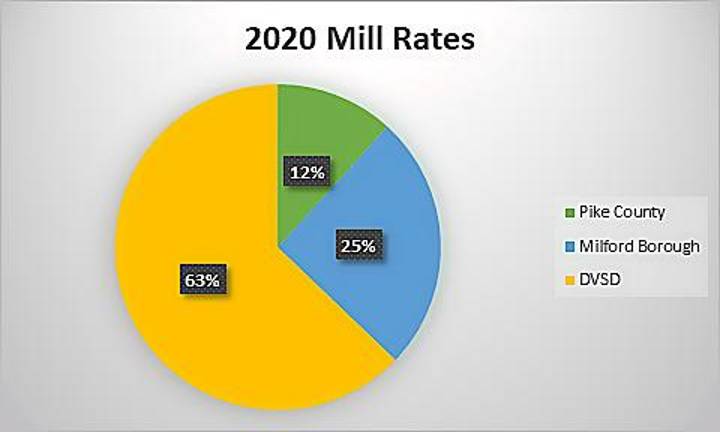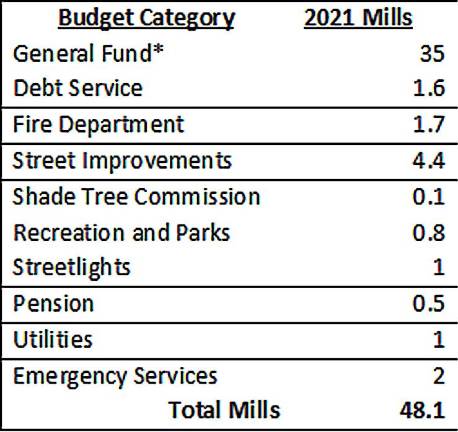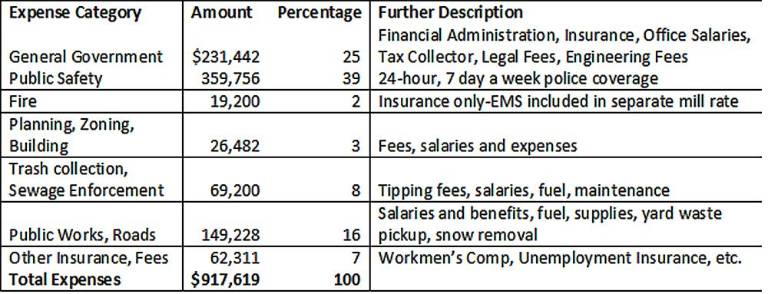Council approves Milford Borough budget for 2021
Milford. One of the highlights this year is a millage increase to support local ambulance services in the borough, a proposition that voters approved on Election Day by an overwhelming 482-112. The borough council provided explanations and charts to help taxpayers understand the new budget.




The Milford Borough Council approved its budget on Tuesday, and prepared an informational letter to help taxpayers understand it.
One of the highlights this year is a millage increase to support local ambulance services in the borough, a proposition that voters approved on Election Day by an overwhelming 482-112. The council set the mill rate at 48.1 mills, an increase of 2 mills. Prior to the ambulance vote, the mill rate had been 46.1 mills for over a decade.
The council provided explanations and charts about property taxes in the borough, how they are determined, and how the borough spends what is paid in property tax. The data is current as of July 2020.
What is the millage rate?
A millage rate, also known as a mill rate, is used to determine how much a property owner owes in property taxes.
One mill is equal to 0.1% of your property’s assessment. To determine the portion of your property tax that is for the Borough, you take your taxable assessed value x.001 x mill rate = Borough property tax.
How do I find out what my property’s assessment is?
The assessed value is noted on your property tax bill and can also be found online at Pike County’s GIS system, which includes every property in the county.
The total assessment of all 555 taxable parcels in Milford Borough is $20,449,020, with an average of $36,845. The average includes commercial properties, so the assessment on most single-family homes in the borough is below the average.
There are another 50 parcels in the borough that comprise an additional $3,073,230 of assessed value that are tax-exempt. These “exempt” parcels include churches, government buildings and others. The borough is the Pike County seat and so has a disproportionate share of exempt properties.
Milford Borough has the second-lowest taxable assessed value of all 13 municipalities in Pike County; only rural Porter Township is lower. Because the borough is relatively small, has many exempt properties, and provides a higher level of services than most other municipalities in the county, the millage rate is higher than many of its neighbors.
How is the assessment determined?
Properties in Pike County are assessed at 25% of the estimated 1994 fair market value of the property. Pike County has not had a reassessment since 1994, except for properties that are improved, subdivided or combined. Reassessment is typically undertaken by the county, as it is a costly process.
Other property taxes
Property taxes are paid twice a year, the county and borough taxes in the spring and the school district taxes in the fall. The pie chart (chart 1) and the summary of mill rates charged in 2020 (chart 2) breaks out the percentages of each. Milford Borough taxes represent one-quarter of property owners’ total real estate property tax bill.
How is the borough property tax spent?
The borough’s 48.1 millage rate is broken down, by the state municipal code, into individual components (chart 3).
The general fund is the largest component of the budget at 35 mills. The statutory maximum set by the legislature for a general fund is 30 mills. To exceed that statutory limit, the borough is required to petition the Court of Common Pleas each year and can be allowed an additional 5 mills. The borough has petitioned the court annually for this for many years.
The earmarked millage rates, for debt service, the fire department, street improvements, Shade Tree Commission, recreation and parks, streetlights, pensions, utilities, and now emergency services (ambulance) are largely self-explanatory. The council is not allowed by law to take the tax revenue earmarked for any of these purposes and spend it elsewhere.
General fund
Where the council’s spending is more discretionary is with the general fund. On the revenue side and based upon the 35 mills, the borough expects to raise a total of $676,711 in property taxes after subtracting a small percentage for uncollected taxes. In addition, the borough expects in 2021 to collect $25,000 in real estate transfer taxes on the sale real property in the borough. The council enacted a local services tax, which will bring in an estimated $15,000. There are other fees, collections of prior year taxes, charges to neighboring municipalities for fire service insurance, fines, permits and other charges, such as the police department providing security to Grey Towers. The total of all revenue in our general fund is estimated to amount to $917,619 in 2021.
Unlike the federal government, the borough is required to balance its budget each year, and so expenses cannot exceed revenue. See chart 4 for the borough’s expenses broken down by category.
The borough council says it has worked hard to reduce certain insurance expenses and obtain new sources of revenue, and also received two grants from the Pike Forward Covid-19 grants programs totaling $114,695.00 for ambulance services and $22,035.72 for other Borough expenses related to the pandemic.
The council that due to rising expenses, such as insurance, payroll, benefits, it will be faced with either cutting services or raising taxes in the near future: “We welcome your input as to how you would like us to proceed as we move forward in our goal to provide you, the Taxpayers of Milford Borough, with quality and efficient services.”
“A committee of three council members and four members of the community have worked diligently since the beginning of this year reviewing each line item of our 2020 budget and actual expenses at regular monthly meetings to include meeting with heads of different budget components. As a result of this review we were able to reduce certain insurance expenses and obtain new sources of revenue.” Mayor Sean Strub and the Milford Borough Council